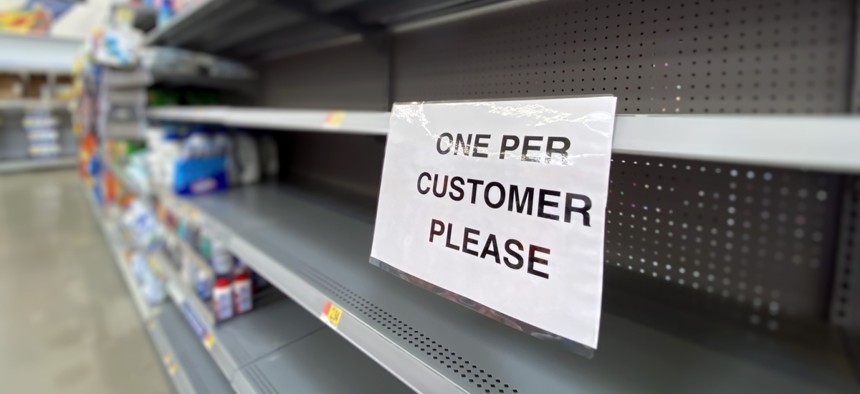The Pentagon Will Use AI to Predict Panic Buying, COVID-19 Hotspots

Orlowski Designs LLC/Shutterstock.com
The prototype can predict trends in supply and demand and infection down to the zip code.
The coronavirus pandemic has revealed that “just-in-time” supply lines don’t always operate as they should. Fortune 500 companies use predictive analytics to improve their ability to deal with the unexpected — and now so do planners with U.S. Northern Command.
The Joint Artificial Intelligence Center, or JAIC, has built a prototype AI tool that uses a wide variety of data streams to predict COVID-19 hotspots and related logistics and supply-chain problems. “You have to be looking a little in the future,” said Nand Mulchandani, chief technical officer at the JAIC.
Dubbed Salus, for the Roman goddess of health and well-being, the tool can work on a scale as wide as the entire nation but can also drill down on specific zip codes and, in some cases, individual stores, said Mulchandani.
Its initial deployment interacts with the information systems of Northern Command and the U.S. National Guard, which are supporting FEMA’s coronavirus response. These systems already have geolocation data that allow them to do mapping, resource allocation, etc.
“What it was lacking was the predictive capability and data overlay,” Mulchandani said. “The insights we gather we are able to pipe directly into the systems that they’re using.”
The prototype is intended to be highly flexible, meaning you can use it to predict a variety of different problems depending on what data you pipe in.
Mulchandani said Salus was first used to aggregate and track data on ventilators, masks, and other medical supplies.
“The next question really was resource allocation like food,” he said.
The process starts with finding pertinent data, or forming relationships with organizations that control it. A lot of the information is publicly available, like census and neighborhood data. Other data comes from corporate entities but is still available under the right partnership. Most important for tracking food-supply issues, Mulchandani said, is sell-through data, information about what products move off store shelves and when.
“We have individual retail partners but also data aggregator partners,” he said.
Mulchandani said the JAIC has technology partners helping with data integration, but couldn’t name them due to nondisclosure agreements. He said Salus comports with U.S. privacy laws; his team is looking for trends in buying, not any individual’s purchases.
“We aren’t using anything so secretive inside the government that wasn’t available” to private companies, he said. “We were just some of the first ones to ask the question: ‘Why don’t we predict this for somebody that has the ability to action it or solve that problem?’”
If this prototype proves valuable, it might see use outside NORTHCOM. “The hope If we do this right, this becomes the supply and logistics platform for all the services. You just plug in different datasets,” said Mulchandani.
It may also become a part of the Joint All-Domain Command and Control, or JADC2, a massive effort to digitally interlink weapons, vehicles and personnel.
“We can confirm that Project Salus is a JADC2 prototype. Project Salus ultimately performs a function that enables a portion of the overall JADC2 concept,” said the JAIC’s Lt. Cdr. Arlo Abrahamson. “Project Salus is operating as a dashboard platform that is fed into the Common Operational Picture (COP) interphases for both NORTHCOM and the National Guard.”



